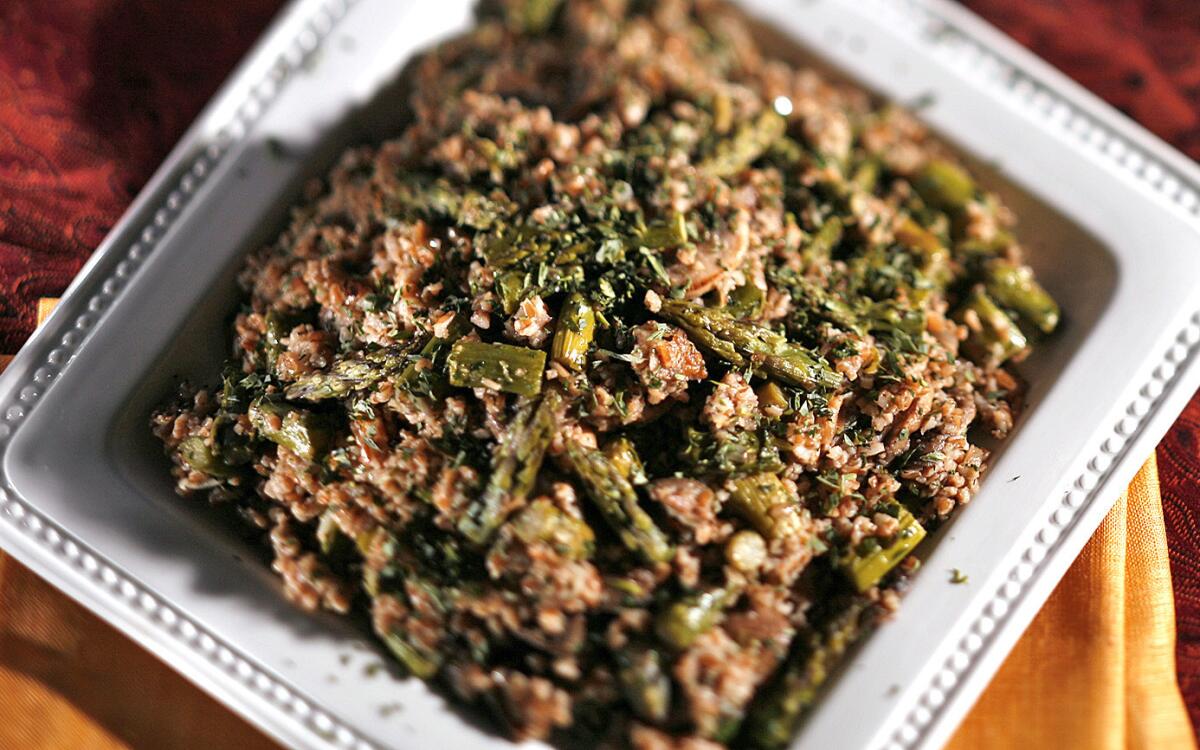Bulgur pilaf with asparagus, mushrooms and tarragon

- Share via
When I lived in the Middle East, I learned that tender tabbouleh salad and crunchy fried kibbeh, the celebrated Levantine croquette, share a key ingredient: bulgur. Since ancient times, bulgur has been a staple in the Fertile Crescent, where it is popular today as pilaf and is used in a variety of other dishes, including stuffed vegetables, lentil entrees, meat stews and stuffings for poultry. In fact, the word “bulgur” comes from Turkish, and southeastern Turkey may be the area where wheat was first cultivated.
Bulgur could be considered one of the world’s first convenience foods. To be made into bulgur, wheat grains are parboiled, dried, ground and sifted to separate the pieces into different sizes. This process makes bulgur one of the quickest-cooking whole grains. In fact, bulgur does not need to be cooked at all. Soaking bulgur in water softens it enough to make it pleasant to eat, and this is the classic way to prepare it for salads such as tabbouleh and its spicy cousin kisir, flavored with red pepper paste and cumin.
I use bulgur as a substitute for longer-cooking grains to speed up the preparation of casseroles, soups and desserts. For example, in Noah’s pudding, a nut, fruit and honey dessert that has been a favorite of mine since I first tasted it in Istanbul pudding shops, I replace the customary whole wheat berries with bulgur.
You can find bulgur in well-stocked supermarkets and natural foods stores. Middle Eastern markets have more varieties, often labeled by numbers: Bulgur No. 1 is finely ground, No. 2 is medium or medium-fine, No. 3 is coarse or medium-coarse, and No. 4 is coarse or extra-coarse. (The package descriptions of different companies vary slightly.) In general, cooks prefer the smallest bulgur for making lamb tartar, fine or medium bulgur for tabbouleh-type salads and fried kibbeh and larger sizes for pilafs and soups.
Bulgur is different from cracked wheat, which is raw. I’ve seen packages labeled bulgur cracked wheat -- as long as the word “bulgur” is there, you know it’s the quick-cooking kind.
American-milled bulgur is often made from white wheat and is tan and mild in flavor. Some Middle Eastern markets carry darker-hued brown bulgur, which is made from red wheat. According to Mike Orlando of Sunnyland Mills in Fresno, some people use this bulgur, which has a slightly bitter taste due to more tannins, in Lebanese dishes. At some Los Angeles markets, there’s also durum-wheat bulgur that comes from Turkey.
And new varieties of this oldest convenience food are still coming. Orlando told me that bulgur would soon be available made from freekeh (grilled young wheat), farro and Kamut.
Trim the tough ends from the asparagus, reserving the ends for flavoring the broth. Cut the asparagus spears in 1-inch pieces. Cut off 1 thin slice from the tip of each mushroom stem, and reserve the slices to flavor the broth.
To make the broth, combine the asparagus ends, mushroom stem slices, tarragon and parsley stems in a saucepan. Add the water, cover and bring to a boil. Cover and cook over low heat until the broth is aromatic and delicately flavored and the asparagus ends are tender when pierced with a knife, about 30 minutes. Strain and discard the vegetable and herb trimmings.
Return the broth to a boil. Add the asparagus pieces and a pinch of salt. Return to a boil and cook uncovered over medium-high heat until the asparagus is crisp-tender, 3 to 4 minutes. Remove the asparagus with a slotted spoon, rinse briefly with cold water and drain. Pour the broth into a measuring cup and add water if necessary to make 2 cups. Dry the pan.
Heat 1 tablespoon oil and 1 tablespoon butter in the saucepan over medium heat. Add two-thirds cup chopped onion and cook, stirring occasionally, until softened, about 4 minutes. Add the garlic and cook, stirring, for 30 seconds. Add the bulgur and cook, stirring, for 2 minutes. Add the hot asparagus broth, standing back to avoid any steam. Add one-half teaspoon salt and a pinch of pepper. Stir and bring to a boil. Reduce the heat to low, cover and cook without stirring until the broth is absorbed and the bulgur is tender, about 15 minutes. Add the red pepper and mix in lightly. Cover the bulgur and set aside for 5 to 10 minutes.
Meanwhile, halve the mushrooms and slice them about one-fourth-inch thick.
Toast the pine nuts in a skillet over medium-low heat, shaking the pan often, until lightly brown, 2 to 3 minutes. Set aside to cool.
Heat the remaining oil and butter in a large skillet over medium heat. Add the remaining onion and cook, stirring occasionally, until it begins to turn golden, about 5 minutes. Add the mushrooms, salt and pepper and saute over medium-high heat until they are tender, about 3 minutes. If the mushrooms give off liquid, cook the mixture over high heat until it evaporates. Add the asparagus, salt and pepper to taste and saute over medium heat until it is heated through, 1 to 2 minutes.
Fluff the bulgur with a fork and stir in the chopped tarragon and parsley. Stir in the asparagus-mushroom mixture (set aside a few asparagus tips for garnish). Taste and add additional seasoning, tarragon or red pepper if needed. Drizzle over a little olive oil if desired. Serve the pilaf garnished with chopped tarragon and parsley, asparagus tips and toasted pine nuts. This makes about 5 cups pilaf.
Get our Cooking newsletter
Get a taste of Los Angeles — and the world — with recipes and kitchen tricks from the L.A. Times’ Cooking newsletter.
You may occasionally receive promotional content from the Los Angeles Times.















